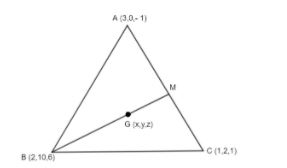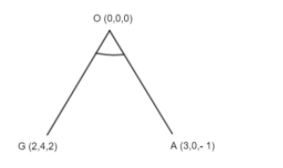
Let A (3, 0, – 1), B (2, 10, 6) and C (1, 2, 1) be the vertices of a triangle and M be the midpoint of AC. If G divides BM in the ratio, 2:1, then \[\cos \left( \angle GOA \right)\] (O being the origin) is equal to:
\[\left( a \right)\dfrac{1}{\sqrt{30}}\]
\[\left( b \right)\dfrac{1}{6\sqrt{10}}\]
\[\left( c \right)\dfrac{1}{\sqrt{15}}\]
\[\left( d \right)\dfrac{1}{2\sqrt{15}}\]
Answer
576.3k+ views
Hint: We are given M is the midpoint of AC. So, we get the line BM is the median as G is the point on BM on dividing it into 2:1. We will get by definition of the centroid that G is the centroid then the coordinate of G is given by \[x=\dfrac{{{x}_{1}}+{{x}_{2}}+{{x}_{3}}}{3},y=\dfrac{{{y}_{1}}+{{y}_{2}}+{{y}_{3}}}{3},z=\dfrac{{{z}_{1}}+{{z}_{2}}+{{z}_{3}}}{3}.\] Then for finding cos of the angle ROA, we use \[\cos \left( \angle ROA \right)=\dfrac{\left( OR \right).\left( OA \right)}{\left| OR \right|\left| OA \right|}.\] To do so we will find the magnitude of OR and OA and then find the dot product OR.OA.
Complete step-by-step answer:
We are given the coordinates of the triangle ABC as A (3, 0, – 1), B (2, 10, 6) and C (1, 2, 1). We have M as the midpoint of AC and G is the point on BM that divides BM in the ratio 2:1. We know that as M is the midpoint, so BM is the median of triangle ABC. Now, the point on the median which divides the median in 2:1 is known as the centroid.
As G lies on the median BM and divides BM in the ratio 2:1, so it means G is the centroid.

Now we know that coordinate of the centroid G is given as
\[x=\dfrac{{{x}_{1}}+{{x}_{2}}+{{x}_{3}}}{3},y=\dfrac{{{y}_{1}}+{{y}_{2}}+{{y}_{3}}}{3},z=\dfrac{{{z}_{1}}+{{z}_{2}}+{{z}_{3}}}{3}\]
where \[\left( {{x}_{1}},{{y}_{1}},{{z}_{1}} \right),\left( {{x}_{2}},{{y}_{2}},{{z}_{2}} \right),\left( {{x}_{3}},{{y}_{3}},{{z}_{3}} \right)\] are the coordinates of the vertex.
As the vertex, we have A (3, 0, – 1), B (2, 10, 6), C (1, 2, 1). So, we get the coordinate of G as
\[x=\dfrac{3+2+1}{3}=\dfrac{6}{3}=2\]
\[y=\dfrac{2+10+2}{3}=\dfrac{12}{3}=4\]
\[z=\dfrac{-1+6+1}{3}=\dfrac{6}{3}=2\]
So, we have the coordinate as G (2, 4, 2).
Now, we have to find the cos of \[\angle GOA\] where O is the origin.

We know that the cos angle between the two vectors is given as
\[\cos \left( \angle XOY \right)=\dfrac{OX.OY}{\left| OX \right|\left| OY \right|}\]
So, for \[\angle GOA\] we will get,
\[\cos \left( \angle GOA \right)=\dfrac{OG.OA}{\left| OG \right|\left| OA \right|}\]
So, for G (2, 4, 2) and O (0, 0, 0) we have,
\[OG=\left( 2-0 \right)i+\left( 4-0 \right)j+\left( 2-0 \right)k\]
\[\Rightarrow OG=2i+4j+2k\]
For A (3, 0, – 1) and O (0, 0, 0), we have,
\[OA=\left( 3-0 \right)i+\left( 0-0 \right)j+\left( -1-0 \right)k\]
\[\Rightarrow OA=3i-k\]
Now,
\[\left| OG \right|=\sqrt{{{2}^{2}}+{{4}^{2}}+{{2}^{2}}}\]
\[\Rightarrow \left| OG \right|=\sqrt{4+16+4}\]
\[\Rightarrow \left| OG \right|=\sqrt{24}\]
And
\[\left| OA \right|=\sqrt{{{3}^{2}}+{{\left( -1 \right)}^{2}}}\]
\[\Rightarrow \left| OA \right|=\sqrt{10}\]
Also,
\[OA.OG=\left( 3i-k \right)\left( 2i+4j+2k \right)\]
\[\Rightarrow OA.OG=6-2\]
\[\Rightarrow OA.OG=4\]
Putting this value in \[\cos \left( \angle GOA \right).\]
\[\cos \left( \angle GOA \right)=\dfrac{OA.OG}{\left| OA \right|\left| OG \right|}\]
\[\Rightarrow \cos \left( \angle GOA \right)=\dfrac{4}{\left| \sqrt{10} \right|\left| \sqrt{24} \right|}\]
After simplification we get,
\[\Rightarrow \cos \left( \angle GOA \right)=\dfrac{4}{2\times 2\times \sqrt{15}}\]
\[\Rightarrow \cos \left( \angle GOA \right)=\dfrac{1}{\sqrt{15}}\]
So, the correct answer is “Option C”.
Note: To simplify the square root we need to factorize it. \[\sqrt{24}\] can be written as \[\sqrt{24}=\sqrt{2\times 2\times 2\times 3}\] and \[\sqrt{10}=\sqrt{2\times 5}.\] So,
\[\sqrt{24}\times \sqrt{10}=\sqrt{2\times 2\times 2\times 2\times 3\times 5}\]
2 comes out two times as it makes a pain that gives us \[2\times 2\times \sqrt{15}.\] This we use while simplifying. Also, remember that |OG| means the magnitude of OG which is given as \[\sqrt{{{x}^{2}}+{{y}^{2}}+{{z}^{2}}}\] if OG is given as \[x\widehat{i}+y\widehat{j}+2\widehat{k.}\]
Complete step-by-step answer:
We are given the coordinates of the triangle ABC as A (3, 0, – 1), B (2, 10, 6) and C (1, 2, 1). We have M as the midpoint of AC and G is the point on BM that divides BM in the ratio 2:1. We know that as M is the midpoint, so BM is the median of triangle ABC. Now, the point on the median which divides the median in 2:1 is known as the centroid.
As G lies on the median BM and divides BM in the ratio 2:1, so it means G is the centroid.

Now we know that coordinate of the centroid G is given as
\[x=\dfrac{{{x}_{1}}+{{x}_{2}}+{{x}_{3}}}{3},y=\dfrac{{{y}_{1}}+{{y}_{2}}+{{y}_{3}}}{3},z=\dfrac{{{z}_{1}}+{{z}_{2}}+{{z}_{3}}}{3}\]
where \[\left( {{x}_{1}},{{y}_{1}},{{z}_{1}} \right),\left( {{x}_{2}},{{y}_{2}},{{z}_{2}} \right),\left( {{x}_{3}},{{y}_{3}},{{z}_{3}} \right)\] are the coordinates of the vertex.
As the vertex, we have A (3, 0, – 1), B (2, 10, 6), C (1, 2, 1). So, we get the coordinate of G as
\[x=\dfrac{3+2+1}{3}=\dfrac{6}{3}=2\]
\[y=\dfrac{2+10+2}{3}=\dfrac{12}{3}=4\]
\[z=\dfrac{-1+6+1}{3}=\dfrac{6}{3}=2\]
So, we have the coordinate as G (2, 4, 2).
Now, we have to find the cos of \[\angle GOA\] where O is the origin.

We know that the cos angle between the two vectors is given as
\[\cos \left( \angle XOY \right)=\dfrac{OX.OY}{\left| OX \right|\left| OY \right|}\]
So, for \[\angle GOA\] we will get,
\[\cos \left( \angle GOA \right)=\dfrac{OG.OA}{\left| OG \right|\left| OA \right|}\]
So, for G (2, 4, 2) and O (0, 0, 0) we have,
\[OG=\left( 2-0 \right)i+\left( 4-0 \right)j+\left( 2-0 \right)k\]
\[\Rightarrow OG=2i+4j+2k\]
For A (3, 0, – 1) and O (0, 0, 0), we have,
\[OA=\left( 3-0 \right)i+\left( 0-0 \right)j+\left( -1-0 \right)k\]
\[\Rightarrow OA=3i-k\]
Now,
\[\left| OG \right|=\sqrt{{{2}^{2}}+{{4}^{2}}+{{2}^{2}}}\]
\[\Rightarrow \left| OG \right|=\sqrt{4+16+4}\]
\[\Rightarrow \left| OG \right|=\sqrt{24}\]
And
\[\left| OA \right|=\sqrt{{{3}^{2}}+{{\left( -1 \right)}^{2}}}\]
\[\Rightarrow \left| OA \right|=\sqrt{10}\]
Also,
\[OA.OG=\left( 3i-k \right)\left( 2i+4j+2k \right)\]
\[\Rightarrow OA.OG=6-2\]
\[\Rightarrow OA.OG=4\]
Putting this value in \[\cos \left( \angle GOA \right).\]
\[\cos \left( \angle GOA \right)=\dfrac{OA.OG}{\left| OA \right|\left| OG \right|}\]
\[\Rightarrow \cos \left( \angle GOA \right)=\dfrac{4}{\left| \sqrt{10} \right|\left| \sqrt{24} \right|}\]
After simplification we get,
\[\Rightarrow \cos \left( \angle GOA \right)=\dfrac{4}{2\times 2\times \sqrt{15}}\]
\[\Rightarrow \cos \left( \angle GOA \right)=\dfrac{1}{\sqrt{15}}\]
So, the correct answer is “Option C”.
Note: To simplify the square root we need to factorize it. \[\sqrt{24}\] can be written as \[\sqrt{24}=\sqrt{2\times 2\times 2\times 3}\] and \[\sqrt{10}=\sqrt{2\times 5}.\] So,
\[\sqrt{24}\times \sqrt{10}=\sqrt{2\times 2\times 2\times 2\times 3\times 5}\]
2 comes out two times as it makes a pain that gives us \[2\times 2\times \sqrt{15}.\] This we use while simplifying. Also, remember that |OG| means the magnitude of OG which is given as \[\sqrt{{{x}^{2}}+{{y}^{2}}+{{z}^{2}}}\] if OG is given as \[x\widehat{i}+y\widehat{j}+2\widehat{k.}\]
Recently Updated Pages
Master Class 12 English: Engaging Questions & Answers for Success

Master Class 12 Business Studies: Engaging Questions & Answers for Success

Master Class 12 Economics: Engaging Questions & Answers for Success

Master Class 12 Social Science: Engaging Questions & Answers for Success

Master Class 12 Maths: Engaging Questions & Answers for Success

Master Class 12 Chemistry: Engaging Questions & Answers for Success

Trending doubts
What are the major means of transport Explain each class 12 social science CBSE

Which are the Top 10 Largest Countries of the World?

Draw a labelled sketch of the human eye class 12 physics CBSE

Explain sex determination in humans with line diag class 12 biology CBSE

Explain sex determination in humans with the help of class 12 biology CBSE

Differentiate between homogeneous and heterogeneous class 12 chemistry CBSE




